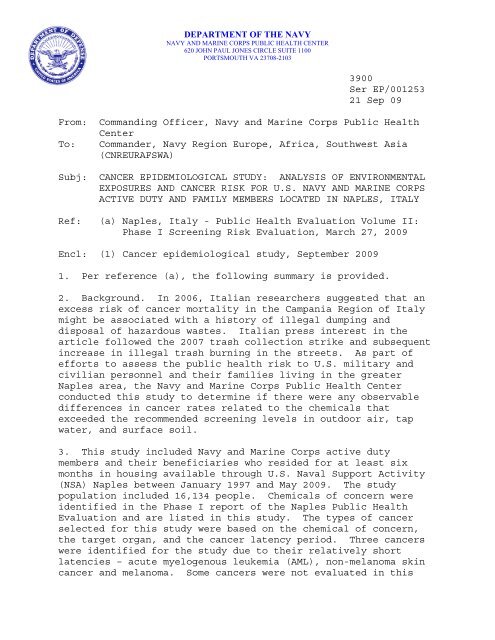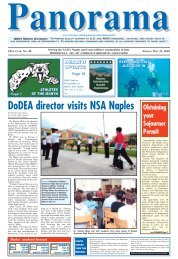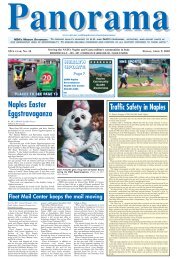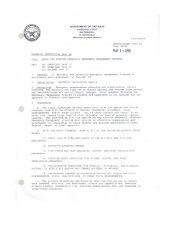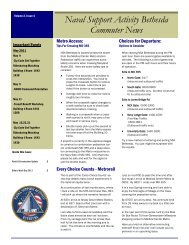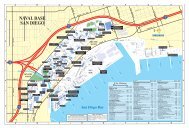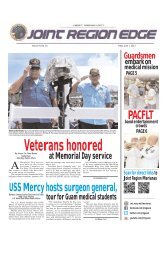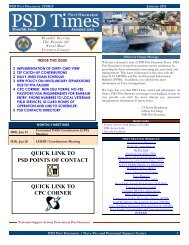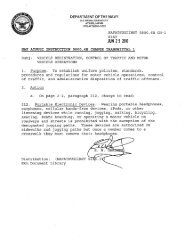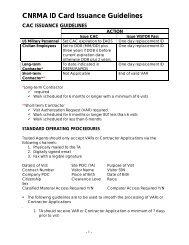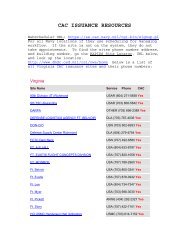NMCPHC EpiData Center - CNIC - U.S. Navy
NMCPHC EpiData Center - CNIC - U.S. Navy
NMCPHC EpiData Center - CNIC - U.S. Navy
You also want an ePaper? Increase the reach of your titles
YUMPU automatically turns print PDFs into web optimized ePapers that Google loves.
DEPARTMENT OF THE NAVY<br />
NAVY AND MARINE CORPS PUBLIC HEALTH CENTER<br />
620 JOHN PAUL JONES CIRCLE SUITE 1100<br />
PORTSMOUTH VA 23708-2103<br />
3900<br />
Ser EP/001253<br />
21 Sep 09<br />
From: Commanding Officer, <strong>Navy</strong> and Marine Corps Public Health<br />
<strong>Center</strong><br />
To: Commander, <strong>Navy</strong> Region Europe, Africa, Southwest Asia<br />
(CNREURAFSWA)<br />
Subj: CANCER EPIDEMIOLOGICAL STUDY: ANALYSIS OF ENVIRONMENTAL<br />
EXPOSURES AND CANCER RISK FOR U.S. NAVY AND MARINE CORPS<br />
ACTIVE DUTY AND FAMILY MEMBERS LOCATED IN NAPLES, ITALY<br />
Ref: (a) Naples, Italy - Public Health Evaluation Volume II:<br />
Phase I Screening Risk Evaluation, March 27, 2009<br />
Encl: (1) Cancer epidemiological study, September 2009<br />
1. Per reference (a), the following summary is provided.<br />
2. Background. In 2006, Italian researchers suggested that an<br />
excess risk of cancer mortality in the Campania Region of Italy<br />
might be associated with a history of illegal dumping and<br />
disposal of hazardous wastes. Italian press interest in the<br />
article followed the 2007 trash collection strike and subsequent<br />
increase in illegal trash burning in the streets. As part of<br />
efforts to assess the public health risk to U.S. military and<br />
civilian personnel and their families living in the greater<br />
Naples area, the <strong>Navy</strong> and Marine Corps Public Health <strong>Center</strong><br />
conducted this study to determine if there were any observable<br />
differences in cancer rates related to the chemicals that<br />
exceeded the recommended screening levels in outdoor air, tap<br />
water, and surface soil.<br />
3. This study included <strong>Navy</strong> and Marine Corps active duty<br />
members and their beneficiaries who resided for at least six<br />
months in housing available through U.S. Naval Support Activity<br />
(NSA) Naples between January 1997 and May 2009. The study<br />
population included 16,134 people. Chemicals of concern were<br />
identified in the Phase I report of the Naples Public Health<br />
Evaluation and are listed in this study. The types of cancer<br />
selected for this study were based on the chemical of concern,<br />
the target organ, and the cancer latency period. Three cancers<br />
were identified for the study due to their relatively short<br />
latencies – acute myelogenous leukemia (AML), non-melanoma skin<br />
cancer and melanoma. Some cancers were not evaluated in this
study because they had latency periods longer than the study<br />
period. Incidence rates and 95 percent confidence intervals (95<br />
percent CI) were calculated where appropriate.<br />
4. The study found nine cases of non-melanoma skin cancer, less<br />
than five cases of AML, and less than five cases of melanoma.<br />
The unadjusted incidence rate for non-melanoma skin cancer was<br />
14.4 cases (95 percent CI: 6.6 – 27.4) per 100,000 person-years.<br />
Because most cancer rates are highly influenced by age, rates<br />
should be adjusted to account for the distribution of age in a<br />
study population. The number of cases found in this study was<br />
too small to use the age adjustment methods recommended by the<br />
National Cancer Institute. Even though the study was unable to<br />
age-adjust the rates, the most conservative comparison was well<br />
below the incidence rates published in the professional<br />
literature. The incidence rates for AML and melanoma were not<br />
calculated due to the low numbers of cases.<br />
5. Overall, the findings of this study did not suggest an<br />
excess of cancer and were consistent with cancer rates observed<br />
in populations with an average age less than 50 years old.<br />
6. My point of contact for this study is Dr. Chris Rennix, ScD<br />
MS CIH, at (757) 953-0955 or christopher.rennix@med.navy.mil.<br />
B. A. COHEN<br />
2


